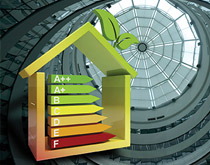The third annual Better Buildings Case Competition, hosted by the U.S. Department of Energy, won’t be mistaken for some Ivory Tower discussion. Through “real-world” cases, it challenges the next generation of engineers, entrepreneurs, and policymakers to devise strategies for reducing energy waste and improving the efficiency of commercial buildings.
 Among the 25 universities fielding teams, there are plenty of familiar names: Berkeley, Columbia, Georgetown, Harvard, MIT, Princeton, Stanford, Yale, and Carnegie Mellon.
Among the 25 universities fielding teams, there are plenty of familiar names: Berkeley, Columbia, Georgetown, Harvard, MIT, Princeton, Stanford, Yale, and Carnegie Mellon.
Actually, CMU is no stranger to the collegiate competition. In the competition’s inaugural year and second year, CMU has brought home top honors.
For 2014, CMU is represented by the following graduate students: Matthew Plunkett (TPR), Matineh Eyb Poosh (E), Rubén Morón Rojas (A), Casey Canfield (E), Vedran Lešic (a visiting Fulbright scholar in engineering and public policy), Nathaniel Horner (E), and Julian Lamy (E).
All of the teams have roughly three months to prepare before the finals—an all-day workshop in Washington, D.C., where teams present their solutions to expert judging panels.
The CMU team honed in on two cases:
- Property Assessed Clean Energy (PACE) Financing: Develop a program structure and a business plan that states can use to effectively implement PACE financing to improve structures’ energy efficiency.
CMU proposal: Market the benefits after completing energy-efficiency projects, such as productivity improvements and health benefits.
- Restaurant franchises: Deploy energy-efficiency solutions, given complicated ownership, investment, and management structure.
CMU proposal: Create a competition among corporations’ franchisees that includes a cash prize for making the best investment in energy efficiency.
Carnegie Mellon’s interdisciplinary team perseveres for the third consecutive year when both entries win Best Proposal.
—Elizabeth Shestak (DC’03)



